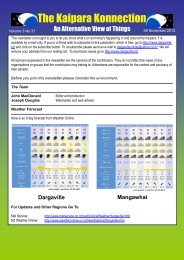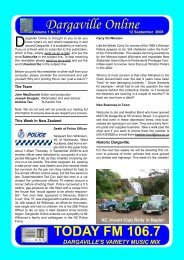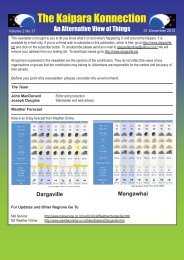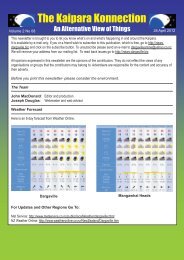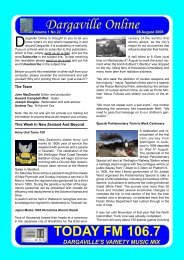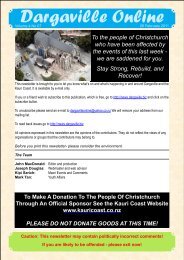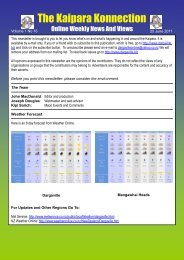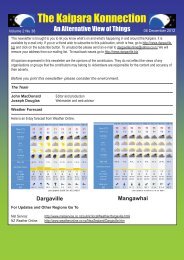29th - Kaipara Konnection - Dargaville.BIZ
29th - Kaipara Konnection - Dargaville.BIZ
29th - Kaipara Konnection - Dargaville.BIZ
Create successful ePaper yourself
Turn your PDF publications into a flip-book with our unique Google optimized e-Paper software.
In America sex is an obsession,<br />
in other parts of the world it is a fact. -- Marlene Dietrich<br />
Media Release – Whangarei District Council<br />
No shellfish gathering in Waipu Estuary area of Bream Bay for 28 days<br />
Members of the public are advised not to gather shellfish from the Waipu Estuary and<br />
Bream Bay one kilometre either side of the mouth of the estuary for the next 28 days.<br />
A broken sewer main near McLean’s bridge has spilled up to 40 cubic metres of sewage<br />
into a nearby paddock and stream flowing into the Waipu River. The break has now been<br />
repaired.<br />
People are advised not to enter the water in the estuary or the Bay 1km either side of the<br />
River mouth area for two days, and to follow sensible hygiene precautions if coming into contact with the water.<br />
Wet fish in the estuary should not be caught amd eaten for the next two days.<br />
New Zealand History This Week 29 September – 06 October<br />
1 October 1986 Goods and Service Tax Act comes into force<br />
Initially adding 10% to the cost of most goods and services, GST was a key part of the economic reforms of the fourth<br />
Labour government that were dubbed ‘Rogernomics’.<br />
Minister of Finance Roger Douglas had the opportunity to implement his ‘new right’ reforms after Labour won a landslide<br />
victory in the snap election of July 1984. The new government inherited an alarmingly high budget deficit and overseas<br />
debt, an inflated dollar, and rocketing inflation. The economy was in crisis, and Rogernomics was a ready-made solution<br />
– or so it seemed to many.<br />
It was the days of Ronald Reagan and Margaret Thatcher, and ‘new right’ policies were the latest craze worldwide. But<br />
nowhere else were they implemented with the speed and zeal shown by Douglas and his supporters. New Zealand<br />
was quickly reinvented as one of the most free-market economies in the industrialised world. The agenda came thick<br />
and fast: deregulation, privatisation, the sale of state assets, and the removal of subsidies, tariffs, tax breaks and price<br />
controls.<br />
GST was added to the mix in 1986. Opponents called it a ‘regressive’ tax – one that hits the poorest the hardest<br />
– because people on low incomes tend to spend the greatest proportion of their money on goods and services.<br />
The reforms had come as a surprise to the electorate and the media. A long period of low or negative economic growth<br />
increased public concern, and tens of thousands of people lost their jobs. Worried that things had gone too far, Prime<br />
Minister David Lange put the brakes on after winning re-election in 1987, calling for a ‘pause and a cup of tea’. Lange<br />
forced Roger Douglas to resign from Cabinet in 1988, but he was voted back in by the Labour caucus the following year.<br />
Lange himself resigned shortly afterward.<br />
The rate of GST was increased to 12.5% in 1989 and remained at that level until 2010,<br />
when it was raised to 15%. There is disagreement to this day about whether the reforms<br />
were a failed experiment or a necessary step towards a stronger economy.<br />
Image: Roger Douglas on the steps of Parliament (Timeframes)



